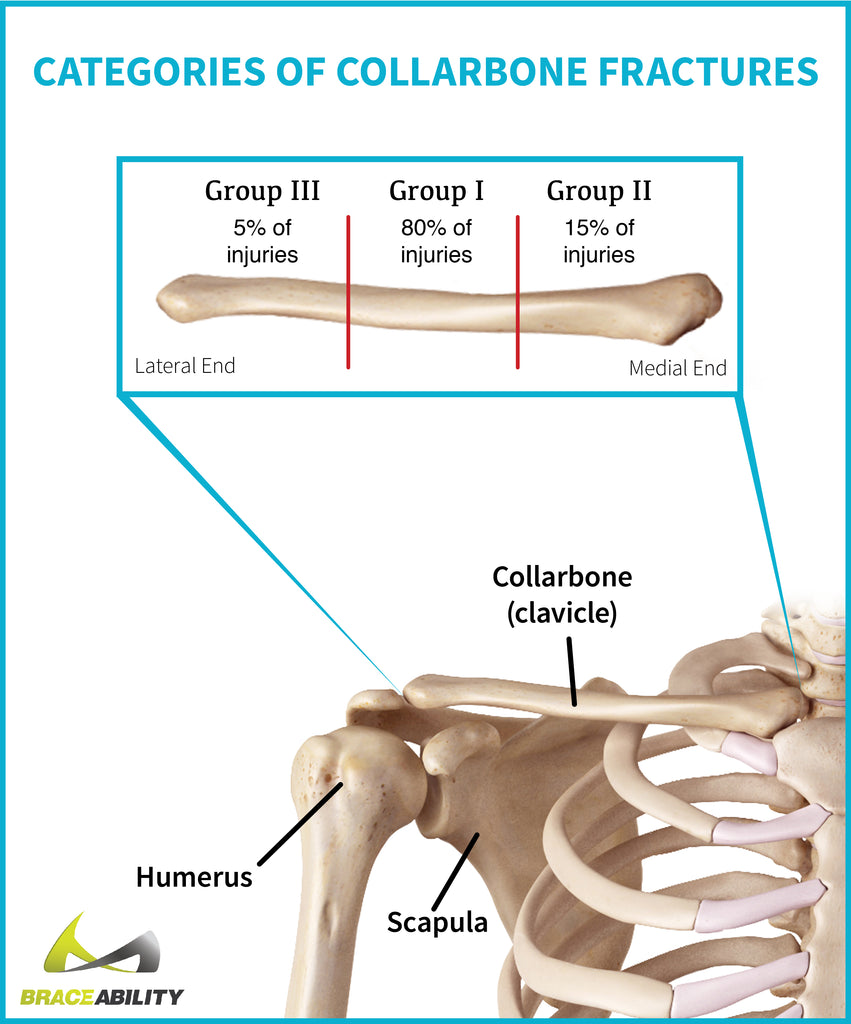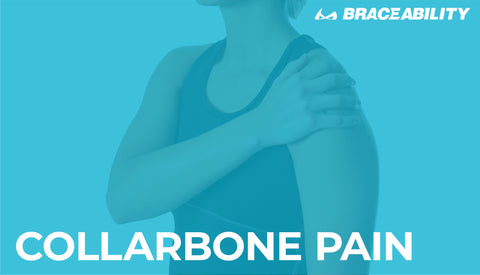Clavicle Fractures
There are many different causes or conditions that result in pain or discomfort in your collarbone. Your collarbone (also known as clavicle) is the prominent bone connecting your shoulder blades to your breastbone and is located on both sides of your upper chest. This bone is easily located and seen due to the proximity of the bone to your skin.

This level of proximity leaves the clavicle bone at a high risk of injury or trauma including fractures/breaks, infections, and dislocations.
How Do I Know If I’ve Broken or Fractured My Clavicle?
Clavicle fractures are the most common cause of collarbone pain and make up for 5% of all fractures. In most cases, clavicle fractures are a result of a direct blow to the shoulder such as falling on an outstretched hand or shoulder, car accidents, etc. Clavicle fractures are most common in children and young adults under the ages of 25. Fractures to the collarbone are also common in men over the age of 55, and women over the age of 75.
Different signs and symptoms that you may have fractured your clavicle include:
- Sagging or drooping of your shoulder
- Inability to move or lift your arm
- Rapid swelling
- Bump or deformity over the skin at the site of injury
- Bruising or tenderness over the bone
- Difficulty breathing on the side of injury
- Dizziness
If you experience any of these symptoms, it’s recommended to see your doctor immediately. Your doctor will help diagnose your injury by asking questions and examining your clavicle area. In addition, your doctor may:
- Check your blood flow
- Examine if there’s damage to your nerves or blood vessels
- Measure the strength of your shoulder
- Measure the level of motion in your shoulder area
- Listen to your lungs, to see if any damage occurred to them as well
- Order an X-ray, to determine what type of break it is
Don’t think you’ve fractured your clavicle but are still experiencing pain? There can be many different complications that may arise causing collarbone pain. (link to collarbone pain library article)
3 Different Categories of Fractures to the Collarbone
Clavicle fractures/breaks are classified into three different groups, based on the type of break:

Group I
This non-operative fracture occurs in the middle of the clavicle bone and constitutes as the most common type of injury to the collarbone. This specific type of fracture accounts for around 80% of all clavicle fractures. Fortunately, it usually is the least severe and can be easily treated by using a simple support (shoulder sling) or immobilization (clavicle brace).
For immobilization of the bone, it’s useful to wear a clavicle figure eight brace because it not only helps to support the collarbone but lifts up the shoulders as well. This brace is preferred because it allows you to have both of your hands completely free from constraint.
Did your child fracture or break their collarbone? Check out our pediatric clavicle brace for the perfect size for your kid!
Along with a clavicle support brace, physical therapy, exercises, ice, and anti-inflammatory medications can be used to help ease your pain and speed up recovery.
The recovery time, as with many other injuries, depends on many different factors including age, the severity of the injury, and activities you do. With this type of fracture, the normal healing time is around 4-6 weeks for adults. For infants and adolescents, the normal healing time can be around 3-6 weeks.
Group II
Unfortunately, compared to group I fracture, surgery is most likely. This fracture is located in the distal part of the clavicle bone and accounts for around 10-15% of all clavicle fractures. Distal clavicle fractures are divided into three types: non-displaced, displaced, and articular. Non-displaced, the bone has cracked part or all the way through but stays align. Displaced, the bone breaks in the two ends and is separated out of their normal position, sometimes piercing through the skin or contained in the skin. Articular, fracture involves the joint surface of the bone.
Usually, whether you have a non-displaced, displaced, or articular fracture, surgery is recommended to help treat your fracture. Surgery will help line the bones back in place to help them heal properly overtime. There are different types of surgery that may be used: pins or screws/plates. For a simple non-displaced fracture, your surgeon may place pins in the bones and remove them when you’re healed. For more severe fractures, where the bone may be in fragments, your surgeon may place screws or plates to hold your bone back together.
After your surgery, you may need to have post-op checkups and physical therapy appointments to help observe and strengthen your collarbone. Healing time after surgery requires more time compared to immobilization or sling. It usually takes around 1-3 months to completely recover from surgery.
Group III
Amongst the three different groups of clavicle fractures, this is the least common or rare case, accounting for around 5% of collarbone injuries. This fracture is located in the medial part of your collarbone, specifically where the bone connects to your ribs. Group II fractures are a result of a considerably strong direct blow to your chest.
Along with group II, this fracture can depend on the severity and placement of your injury. Usually, if you have a non-displaced fracture, immobilization using a clavicle support brace is needed. If you have a displaced fracture, this may require surgery and you may want to talk to your doctor about your options.
Recovery time is about the same as the other two groups especially if you only require a clavicle support brace. If you require surgery, the time it takes to recover is usually different for every person but may be around 1-3 months.
I’ve Fractured My Clavicle, Now What?
There are multiple different treatment options available for clavicle injuries. Each different treatment option depends on the type and severity of your specific fracture/break. Luckily, most fractures are treated with simple methods such as braces, anti-inflammatory medications, physical therapy, and exercises. As mentioned above, learning about whether you have group I, group II, or a group III fracture will help determine your treatment plan.
Other ways to help recover from a collarbone break/fracture:
- Use pillows at night to help support and stabilize your collarbone, neck, and back. This will help you sleep more comfortably while recovering.
- Use ice packs every day for around 20 minutes to help reduce swelling and inflammation.
- Moving your elbow, fingers, and hands will help ease your collarbone into full motion. Even if you can only move them around a little bit, this will help strengthen your other muscles around the injury.
- Avoid any contact sports or high-level activities that may further injure or tire out your clavicle for about 10-12 weeks. Listen to your doctor about when you can return to such activities.
Here is some information to learn more about treatment options or braces for a broken collarbone.
Ways to Prevent an Injury to Your Clavicle/Collarbone
Although many collarbone injuries or fractures are a result of an accident and happen unexpectedly, there are some preventative measures you can take to help reduce these accidents. It is common for your child or yourself to injury their collarbone from playing high contact sports like hockey, football, basketball, and wrestling. By wearing protective gear such as helmets, padding, face guards you can help reduce the risk of injury. In addition to protective gear, learning the appropriate way and rules for your specific sport can help ensure your safety against the rough or foul play.
Another way to help prevent an injury to your clavicle is to maintain a healthy and well-balanced diet. Eating a plentiful amount of vegetables and other foods that are rich in vitamins can help build strong bones. Aside from a well-balanced diet, drinking adequate amounts of water each day will help reduce the amount of stress on your bones and improve your balance.
Another way to prevent injuries to your clavicle is to do strength training and stretching. Especially if you use your collarbone or muscles around your collarbone frequently, it’s a good idea to do exercises or stretches specifically for this area. Try wearing a posture corrector during the day to help strengthen and train your back, neck, and shoulder muscles. Make sure before exercise you are properly warming up so your muscles don’t become overworked.
Check out BraceAbility's selection of posture braces!
How Common Are Collarbone Fractures in Newborns?

When you’re young, your bones are constantly growing at different speeds. Your collarbone doesn’t completely harden and stop growing until you are about 20 years old; making it one of the most frequently broken bones for kids. In addition, clavicle fractures are the most common injury in newborns during delivery.
Clavicle fractures in newborns are a result of a difficult delivery, larger sized baby, newborn’s shoulder becoming stuck, and a narrow birth canal. In other cases, your doctor may have to break your child’s collarbone in order to deliver the baby.
Signs and symptoms that may accompany a clavicle injury in your newborn:
- Crying or fussiness when moving their arm or shoulder
- Stiffness or stillness in your child’s arm
- Shoulder may appear lower than the opposite shoulder
- Bruising or swelling
Fortunately, clavicle fractures in newborns can heal rapidly without any complications. Sometimes it is advised to immobilize the injury by a soft or loose cloth.









